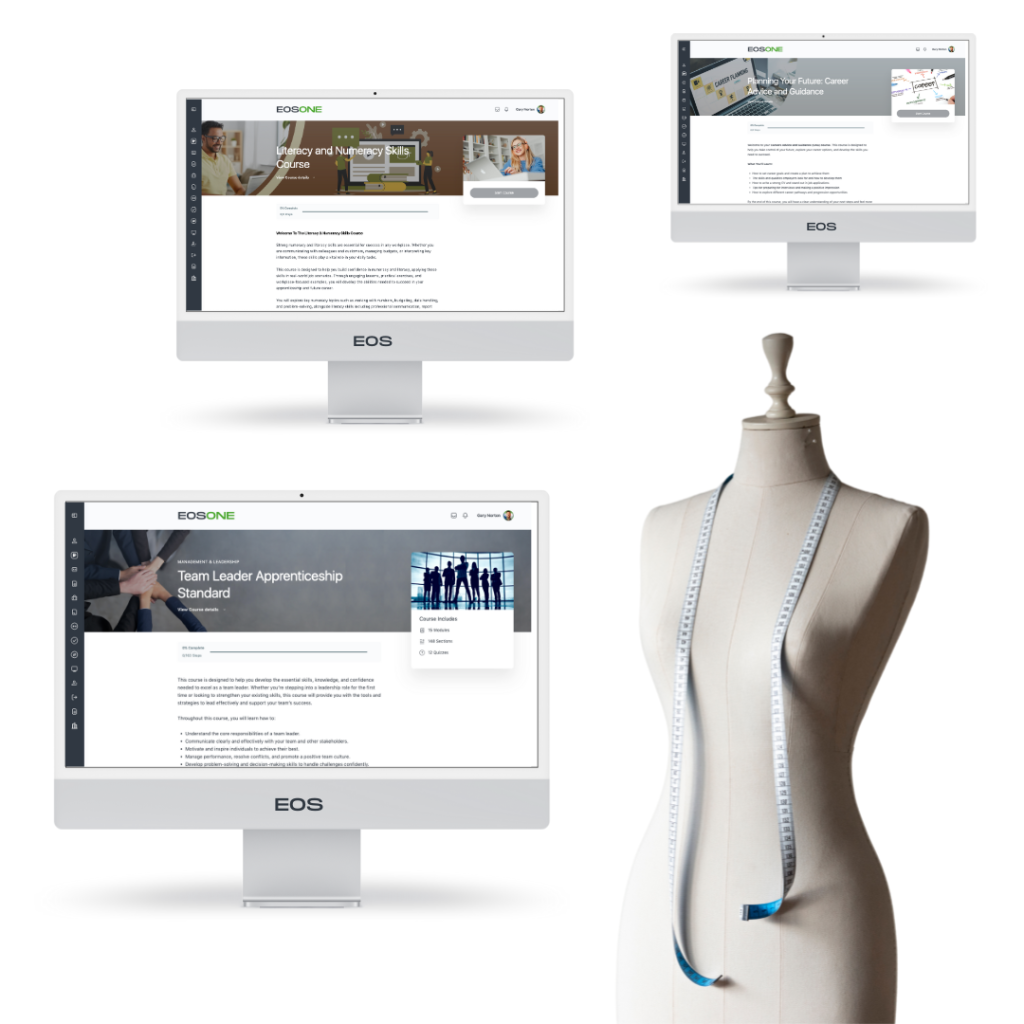Building the Curriculum Machine for Guaranteed Success
High-quality apprenticeship delivery isn’t easy. We know how much is expected of training providers—tight compliance frameworks, diverse learner needs, high employer expectations, and limited time for planning.
From working closely with our customers, we’ve seen first-hand the common curriculum challenges providers face: too much pressure on tutors to design their own delivery plans, a lack of structure around monthly milestones, and difficulty integrating everything from Literacy and Numeracy to enrichment and Careers Advice & Guidance.
In this blog, we want to share what works. We’ll help you look at your curriculum in a new way—as a machine that consistently produces skilled, confident learners. When this machine is well-built and maintained, it works for your learners, your tutors, and your business.
At the end of the blog, find out how EOSONE makes this simple.

Start with the "Specification Sheet"
Every machine needs a blueprint. Your curriculum should begin with a clear end product: a learner fully prepared for EPA, confident in their skills, and able to showcase their achievements.
Ask yourself:
- What should a ‘finished’ learner be able to do?
- What Knowledge, Skills, and Behaviours (KSBs) must they demonstrate?
- What outputs need to be complete—showcases, portfolios, presentations, reviews?
- What does your awarding body or EPAO expect at gateway?
This is your specification sheet. If you’re unclear on this, the rest of the machine will be built on guesswork.
Programme the Machine – Curriculum Content and Structure
Your curriculum components are the input materials. If you don’t feed in the right content in the right order, the machine can’t build the right learner.
Common faults:
- Curriculum content doesn’t follow a logical progression
- Enrichment topics, CAG, and Literacy/Numeracy are bolted on or overlooked
- Units are too complex, disjointed, or not aligned with required KSBs
What to do instead:
- Structure your curriculum so each topic builds on the last
- Start with foundational skills that support later development
- For example: learners should cover communication, feedback, and basic coaching before tackling leadership tasks like appraisals or 1:1s
- Map enrichment, CAG, and Literacy and Numeracy into the programme—not as extras, but as integrated elements that reinforce the apprenticeship standard
Plan by the Month: Think in Cycles, Not Checklists
This is the heart of a well-functioning curriculum machine. Curriculums should be built around monthly delivery cycles.
Why monthly planning works:
- Tutors know exactly what they need to deliver each month
- KSBs are aligned to monthly goals, making progress easier to track
- Monthly delivery naturally supports funding compliance rules
- It’s easy to match OTJ delivery to specific activities
- Learners know exactly what’s expected by the end of each month—deadlines become obvious
- Self-directed learning becomes possible when content is structured in a logical, linear narrative
- If a tutor leaves, a new one can step in and pick up that month’s module without disruption
- Learners falling off-track can be spotted quickly, allowing fast re-engagement—rather than losing 3 months of progress
Create Efficient Processes: Avoid Production Bottlenecks
Even with the right components, poor processes cause jams. If every tutor is delivering differently, or if deadlines are too far apart, you’ll get inconsistent output and missed timelines.
Common faults:
- No clear internal deadlines between start and end date
- Tutors stretched with no central delivery plan
- Reviews and Enrichment/CAG/L&N left to the last minute
What to do instead:
- Set clear monthly milestones for every learner
- Provide delivery teams with a mapped plan that includes content, assessments, and OTJ alignment
- Build in review points and enrichment activity as part of standard monthly delivery—not as last-minute add-ons
Use a Control Panel – Reporting Dashboards
No machine runs without a dashboard. You need live insight into how each learner is progressing through the ‘assembly line’.
Look for:
- Are learners completing modules on time?
- Are reviews being done when scheduled?
- Are knowledge gaps flagged early?
Tools to help:
- Learner RAG ratings
- ILP review tracking
- Progress dashboards
- Tutor reporting templates
If you’re not tracking these things centrally, your machine may be running blind—and faults could go unnoticed until it’s too late.

Maintain the Machine: Keep the Curriculum Updated
Even the best machines break down if left unattended. If the curriculum isn’t regularly maintained, it becomes outdated, misaligned, and ineffective.
Warning signs:
- Learners disengage
- KSBs no longer match employer needs
- Poor feedback or low achievement rates
- Tutors start developing their own workaround content
What to do instead:
- Review your curriculum quarterly—not just after an inspection
- Collect feedback from tutors, learners, and employers
- Update Literacy and Numeracy, CAG delivery, enrichment, and narrative flow based on outcomes and new standards
Support the Operators, Don’t Make Them Engineers
Tutors are operators—not engineers. If you’re asking them to build the machine, run it, and fix it all at once, you’ll see burnout and inconsistency.
Instead of:
- Asking tutors to design the whole course
- Leaving them to create or find resources
- Expecting perfect delivery without structure
Provide:
- A mapped curriculum with flexible delivery methods
- Central resources aligned to each outcome
- Clear expectations for reporting, reviews, and engagement
When tutors have a working machine to operate, they can focus on what they do best—teaching, coaching, and supporting learners.
The Curriculum Machine
A well-built curriculum doesn’t just tick boxes—it runs like a precision-engineered machine. When every part is working together, it produces confident, capable learners who are truly ready for EPA. By treating your curriculum like the engine room of your delivery, you give your tutors clarity, your learners structure, and your organisation the consistency it needs to succeed.
How EOSONE Makes This Simple
Everything in this guide becomes easier when your platform is built for it. In EOSONE, curriculums are prescribed and structured using our effortless VLE block builder. Each monthly block contains sections of content laid out in a clear, linear narrative—making it simple for tutors to follow and intuitive for learners to self-guide.
Enrichment “Hot Topics”, Careers Advice and Guidance, and literacy and numeracy modules are all included as standard. There’s no need to build or plan any of this—it’s already done for you.
As learners move through the curriculum, Knowledge, Skills and Behaviours (KSBs) and Off-the-Job hours are automatically tracked, updating dashboards in real time. Each learner has a personalised ILP for the month, hyperlinked directly to their resources in the VLE—something only an all-in-one system like EOSONE can offer.
Everyone involved in delivery, including employers, gets full visibility through tailored reporting dashboards. And with access to the EOS Content Library, providers have everything they need to deliver high-quality learning, from apprenticeships to short courses and qualifications.

